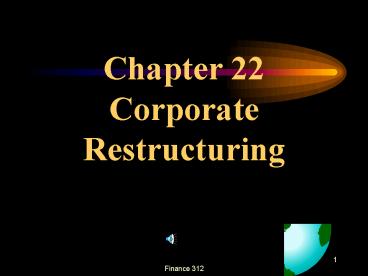Chapter 22 Corporate Restructuring
1 / 27
Title:
Chapter 22 Corporate Restructuring
Description:
Files bankruptcy Fed bankruptcy laws. Finance 312. 17. Why Do Businesses Fail ? ... Prepackaged Bankruptcy ... Bankruptcy. Chapter 7 ... – PowerPoint PPT presentation
Number of Views:4985
Avg rating:3.0/5.0
Title: Chapter 22 Corporate Restructuring
1
Chapter 22Corporate Restructuring
2
External Expansion
Merger Acquisition
Corporate Restructuring
Failure
Bankruptcy
3
Types of Combinations
- Merger A B A
- Vertical Buyer-seller relationship
- Horizontal Compete directly
- Conglomerate Neither
- Geographic market
- Product extension FTC
- Pure
- Consolidation A B C
- Holding company
- Joint venture
- Acquisition Synonymous with merger
4
Leveraged Buyout ( LBO )
- Buyer borrows most of the purchase price
- Purchased assets used as collateral
- Buyers frequently are the managers
- Anticipate CFs sufficient to service debt
- Reasonable ROI
- Sell assets to pay off debt
- Employee Stock Ownership Plan ( ESOP )
- Tax advantage
5
- Stock Purchase
- Acquiring company buys the stock of the target
company - Assumes liabilities
- Asset Purchase
- Acquiring company buys assets of target company
- NO assumption of liabilities
- Tender Offer Hostile takeover
- Purchase the C/S of the merger candidate
- Offering price gt market price
- Induce shareholders to sell
6
What Happens After a Merger ?
- Divestitures
- Part of the company sold for cash
- Spinoff
- Equity carve-out
- Restructurings
- Operational
- Financial
7
Why Has Restructuring Been Increasing ?
- Failure of internal control mechanisms
- Unproductive investment
- Organizational inefficiencies
- Large active investors
- Available financing Junk bonds
- Long economic expansion
- Increased revenues
- Increased asset values
8
Anti-Takeover Measures
- Standstill agreement
- Pacman defense
- Litigation
- Asset/Liability restructuring
- Greenmail
- Staggering board
- Golden parachutes
- Supermajority rule
- Poison pills
- White knight
9
Boardmail
- Institutional investors use it to fight
anti-takeover devices - Requires the board of directors to adopt weaker
anti-takeover measures - In exchange for voting support from institutional
owners - Vote in sympathetic board members
10
Why Do Companies Seek External Growth ?
- Less Expensive
- Economies of scale
- Vertical merger Availability
- Rapid growth
- Diversification
- Tax-loss carryforward
11
Taxes on Mergers
- Cash or nonvoting securities
- Gains are taxable at the time of the merger
- Voting equity securities
- Tax-free
12
Accounting for Mergers
- Purchase method
- Total value paid recorded on books
- Tangible assets at fair market value
- Excess as goodwill Not a tax-deductible
expense - Pooling-of-interest
- Assets recorded at book value
- No goodwill
- Higher NI No deduction for goodwill
- Not effective after January 1, 2001
- Goodwill
- Must be amortized
- Deducted from NI after taxes
13
Valuation of a Merger Candidate
- Comparative P/E Ratio Method
- Examines prices and P/E ratios of similar
companies - Adjusted book value method
- Determine market value of the companys assets
- Discounted C/F method
- Capital budgeting techniques
Future free C/Fs
Risk-adjusted rate
14
Cash
Terms of a Merger
Stock
Other Financial Instruments
15
EPS of the Surviving Company
- E1 E2 E12
- EPSc
- NS1 NS2 ( ER )
- Post-merger price of C/S
- Post-merger P/E
Determined in the marketplace
16
Failures
- Technically insolvent
- Unable to meet current obligations
- Legally insolvent
- Assets lt liabilities
- Bankrupt
- Unable to pay debts
- Files bankruptcy Fed bankruptcy laws
17
Why Do Businesses Fail ?
- Business risk Symptoms
- Industry downturns
- Over expansion
- Inadequate sales
- Increased competition
- Technological change
- Financial risk Symptoms
- Leverage
- Too much S-T debt
- Poor management of A/R, A/P
- Incompetent management
- Fraud, Poor Strategies, Disasters
18
Resolve its Difficulties
Failing Firm
Declare Bankruptcy
19
Reorganization Vs Liquidation
- Reorganize if going-concern value exceeds its
liquidation value - Going-concern
- Liquidation
- Liquidate if liquidation value is more than its
going-concern value
20
Alternatives for C/F Problems
- Stretch A/P Buy a few weeks time
- Debt restructuring Voluntary
- Extension
- Composition
- Suppliers make concessions
- Sell off assets
- Real estate / operating divisions
- Sale and leaseback
- Creditors committee
- Assignment Liquidation outside bankruptcy
21
Chapter 11
(Reorganization)
U. S. Bankruptcy Laws
Chapter 7
(Liquidation)
22
Chapter 11
- Seek protection from creditors
- Attempt to work out a plan of reorganization
- Debtor has 120 days to work out plan of
reorganization - Court may appoint trustee to run the business
- Reorganization plan must be approved
- Court
- Creditors
- SEC Review for fairness and feasibility
- Companys security holders
- 2/3 of dollar amount of debtholders
- Majority of number of debtholders
23
Prepackaged Bankruptcy
- Agreed to by 51 of creditors and 2/3 of debt
before filling under Chapter 11 - Prepack can speed a firm through the bankruptcy
process in a few months
24
Chapter 7
- Court selects a referee
- Handles the administrative procedures
- Arranges a meeting of the creditors
- Creditors select a trustee
- To liquidate the business
- Distribute the proceeds
- According to Chapter 7 priorities
25
Priorities
- Debts satisfied from sale of secured assets
- Administration expenses
- Business expenses After petition before trustee
- Wages owed Three months prior
- Contributions to employee benefit plans
- Customer lay-away deposits
- Taxes owed
- General /unsecured claims Creditors
- P/S and finally C/S holders
26
Chapter 7 Bankruptcy
- Accomplishes three important tasks
- Provides safeguards against fraud by the debtor
- Provides for an equitable distribution of the
debtors assets among the creditors - Allows insolvent debtors to discharge all their
obligations and to start new businesses
unhampered by previous debt
27
Conclusion
- Mergers Acquisitions
- Accounting for Mergers
- Reorganization
- Chapter 11
- Bankruptcy
- Chapter 7































